#Indiana Avenue.
Explore tagged Tumblr posts
Photo
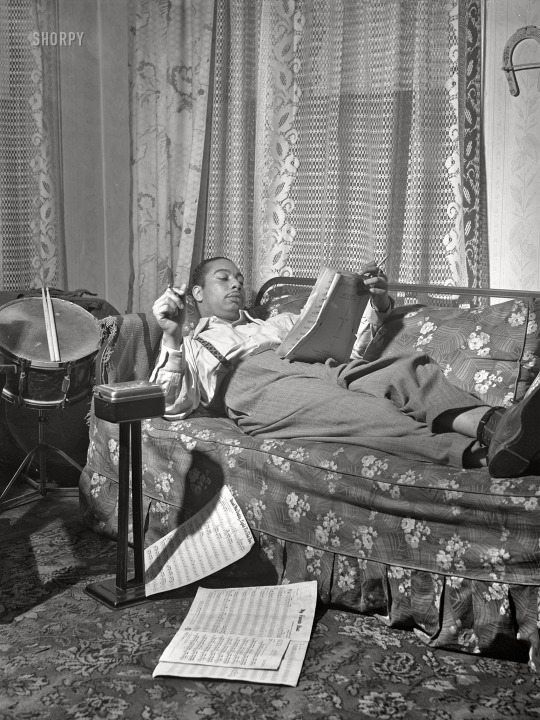
(via Oliver Coleman: 1942 | Shorpy)
April 1942. "Mr. Oliver Coleman, drummer, looking over some music scores in the study of his apartment on Indiana Avenue. Chicago, Illinois." Acetate negative by Jack Delano for the Foreign Information Service of the U.S. Office of Coordinator of Information. View full size.
96 notes
·
View notes
Text

the world is fucked up; Love is all we have left (U2)
#photography#lensblr#imiging#robert indiana#love#new york city#nyc#love is all we have left#u2#songs of experience#original photographers#5th avenue
3 notes
·
View notes
Video
youtube
Do you think Santa could kick your ass? What crimes would you commit to stop your ex's engagement? How would you spend three disastrous years in space? Have you dropped it low for Jesus? Get ready, because we're reviewing Violent Night, Four Samosas, Avenue 5, and Sherman's Showcase and reacting to a bunch of new trailers!
You can also find us on Spotify and Apple Podcasts!
#violent night#four samosas#avenue 5#sherman's showcase#david harbour#john leguizamo#cam gigandet#venk potula#summer bishil#karan soni#hugh laurie#lenora crichlow#josh gad#bashir salahuddin#guardians of the galaxy vol. 3#indiana jones and the dial of destiny#super mario bros. movie#transformers: rise of the beasts#the last of us#gen v#the witcher: blood origin#cocaine bear#the best man: the final chapter#that 90's show
2 notes
·
View notes
Text
sometimes i really wonder why i didn't actually go to college for any sort of zoology and then i remember that i live in fucking indiana where there's almost nothing interesting and i don't wanna move around for any job
#mrowr.txt#ask to tag#i considered ornithology specifically for at least a full year. maybe more#(bird science)#and while i still LOVE birds i dont know if that avenue specifically would be for me?#i do enjoy marine biology but like. so does everyone it seems#but i love love love the life cycle of crusteceans#the process of molting the evolutionary adaptations between species!! aaa#i've also considered specifically bats as a study#and of course. reptiles! i could probably be a very very happy herpetologist honestly#but. indiana. nothing cool here.
1 note
·
View note
Text

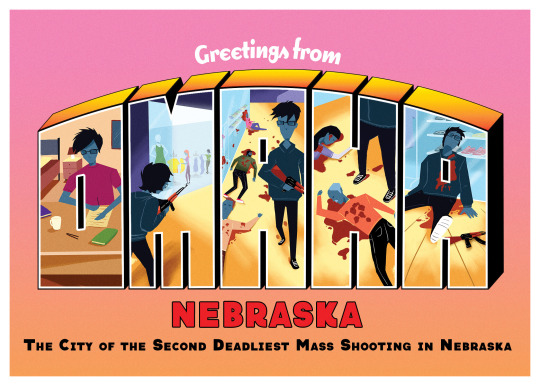

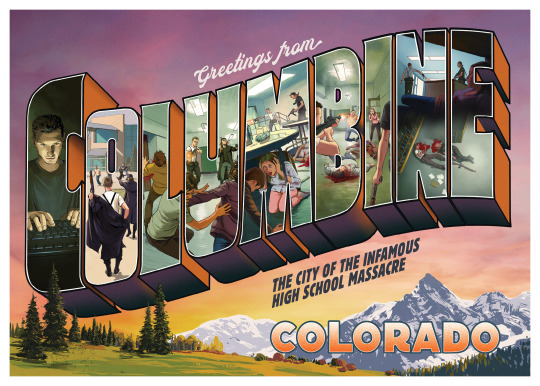

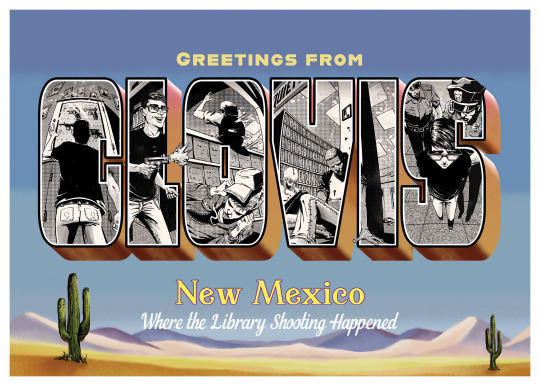
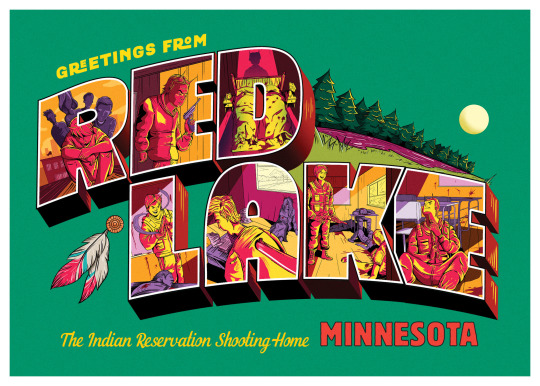


vimeo
“Because the US government was not acting on mass shootings, we directly attacked a trait Americans are most known for: their pride in their country. Change the Ref created the Shamecards, a postcard collection designed to demand gun law reform from Congress. Subverting the traditional greeting cards that depict each city’s landmarks, ours show what cities are becoming known for.”
shamecards.org
There is 54 cards total representing:
Annapolis — Maryland: Capital Gazette Shooting
Atlanta — Georgia: Day Trading Firm Shootings
Benton — Kentucky: Marshall County High School Shooting
Bethel — Alaska: Regional High School Shooting
Binghamton — New York: Binghamton Shooting
Blacksburg — Virginia: Virginia Tech Massacre
Camden – New Jersey: Walk of Death Massacre
Charleston — South Carolina: Charleston Church Shooting
Charlotte — North Carolina: 2019 University Shooting
Cheyenne — Wyoming: Senior Home Shooting
Chicago — Illinois: Medical Center Shooting
Clovis — New Mexico: Clovis Library Shooting
Columbine — Colorado: Columbine
Dayton — Ohio: Dayton Shooting
Edmond — Oklahoma: Post Office Shooting
El Paso — Texas: El Paso Shooting
Ennis — Montana: Madison County Shooting
Essex Junction — Vermont: Essex Elementary School Shooting
Geneva — Alabama: Geneva County Massacre.
Grand Forks — North Dakota: Grand Forks Shooting
Hesston — Kansas: Hesston Shooting
Honolulu — Hawaii: First Hawaiian Mass Shooting
Huntington — West Virginia: New Year's Eve Shooting
Indianapolis — Indiana: Hamilton Avenue Murders
Iowa City — Iowa: University Shooting
Jonesboro — Arkansas: Middle School Massacre
Kalamazoo — Michigan: Kalamazoo Shooting
Lafayette — Louisana: Lafayette Shooting
Las Vegas — Nevada: Las Vegas Strip Shooting
Madison — Maine: Madison Rampage
Meridian — Mississippi: Meridian Company Shooting
Moscow — Idaho: Moscow Rampage
Nashville — Tennessee: Nashville Waffle House shooting
Newtown — Connecticut: Sandy Hook Elementary School Shooting
Omaha — Nebraska: Westroads Mall shooting
Orlando — Florida: Pulse Nightclub Shooting
Parkland — Florida: Parkland School Shooting
Pelham — New Hampshire: Wedding Shooting
Pittsburgh — Pennsylvania: Pittsburgh Synagogue Shooting
Prices Corner — Delaware: Delaware Shooting
Red Lake — Minnesota: Indian Reservation Shooting
Roseburg — Oregon: Umpqua Community Collage Shooting
Salt Lake City — Utah: Salt Lake City Mall Shooting
San Diego — California: San Ysidro Massacre
Santa Fe — Texas: Santa Fe School Shooting
Schofield — Wisconsin: Marathon County Shooting
Seattle — Washington: Capitol Hill Massacre
Sisseton — South Dakota: Sisseton Massacre
St. Louis — Missouri: Power Plant Shooting
Sutherland Springs — Texas: Sutherland Springs Church Shooting
Tucson — Arizona: Tocson Shooting
Wakefield — Massachusetts: Tech Company Massacre
Washington — D.C.: Navy Yard Shooting
Westerly — Rhode Island: Assisted-Living Complex Rampage
57 notes
·
View notes
Text
if we lived on the moon.
Not for the first time, Steve Harrington wishes he lived anywhere but Hawkins, Indiana.
He spots Eddie walking toward him down the grocery store aisle where he’s been waiting for him, shifting a can of baked beans from one hand to the other, dimples on full display.
“Got ‘em! Found the last can, they were shoved all the way to the back of the shelf, can you believe it? Had to reach all the way back.” Eddie stops short where Steve stands with his hands on the shopping cart handle. His eyes raise from the can in his hands to Steve’s face, smile widening. “I can’t wait to make you Wayne’s famous wieners and beans. It was all I would eat when I first moved in with him.” Eddie’s eyes sparkle while he talks, remembering, gaze still on Steve as he leans down to place the can in the bottom of the cart. His smile softens and Steve is transfixed, frozen in place, nearly breathless. “Guess it reminded me of my mom,” he finishes in a near-whisper. It makes Steve wish he’d known him when they were kids, that they’d grown up together and seen each other in every moment of their lives.
As Eddie leans back up out of the cart, a lock of hair falls across his face. Steve’s hand itches to reach out and tuck it behind his ear for him. He glances around, covertly and quickly. Finding their aisle empty, he gives in to his impulse and allows his fingers to brush Eddie’s hair away from his eyes for him before dropping it back onto the cart handle. Eddie blushes, just a little, and brings his own hand up to pull that same hair in front of his face, suddenly bashful.
Maybe it isn’t any where he wants to be. Maybe it’s an any when. Maybe in a year—or two or three or ten—he can touch his boyfriend’s hair without looking over his shoulder to be sure there’s no one watching. Maybe in a year—or two or three or ten—he can grocery shop holding Eddie’s hand and no one will say anything at all. Maybe in ten years, he’ll be allowed to kiss Eddie right in the center of Hawkins where anyone could see them and no one would even care. Maybe then they’ll be allowed to have their date nights at the diner like everyone else, instead of tucked away in the trailer with mismatched candlesticks for a centerpiece and the radio playing their well-worn mixtapes, the ones Steve knows by heart. Maybe it’s just a matter of waiting it out. Maybe then—if he believes in this bright, beautiful future when—he won’t be forced to leave everything behind just to be allowed to love Eddie out in the open, where everyone could see.
They turn to leave the aisle, finished with their shopping, but before they exit the deserted space completely, Steve feels the brush of Eddie’s knuckles against his own as he pushes the cart in front of him, like a butterfly: there suddenly, gentle and then gone.
He has to believe in anywhere and any when.
"i'd hold your hand if we lived on the moon, walking down the avenue. we'd never think twice about who we'd offend and we'd never say we're just friends. no, we'd never say we're just friends. all that i know is i want you forever and nothing like this could be wrong. if people on earth think that they know us better than we do, then i'll live on the moon with you."
is this anything? i obviously didn't know how to end it lol. i'm having big gay sad feelings tonight about homophobia. i rarely write in a universe where homophobia exists, because these are my barbies and i'm the god of this gay little world, but i'm extra sad today. hope you enjoyed this or something. idk. who are ur fave openly gay musicians? i like boygenius, muna, fletcher, etc. trying to get away from u know who, give me recs!!!! ok bye.
#steddie#steddie fic#steddie blurb#steddie drabble#steddie fanfic#steddie fanfiction#stranger things#eddie munson#steve harrington#steve x eddie#steve harrington x eddie munson#tw homophobia#period typical homophobia#steddie ficlet#stranger things fanfic#stranger things fanfiction#stranger things fic
195 notes
·
View notes
Text

State Line Avenue, Hammond, Indiana.
349 notes
·
View notes
Text

Advertisement, To-Morrow Magazine, Feb 1905:
Poetry and Prose -- Bum Books for Me! -- Largest Library Like It FREAK BOOKS Bought, Sold, Rented and Exchanged ----------- Many authors owe their success and popularity to my refusal to admit their books to my library. Bernard Shaw owes his fame to me. I return good books and only keep the rotten stuff. It is the right way to test your books. Only autograph copies considered. Do not try to deceive. ----------- Always Address SERCOMBE HIMSELF 1926 Indiana Avenue CHICAGO I KNOW GOOD BOOKS
71 notes
·
View notes
Text
Cincinnatians Gobbled Up Tales Of Barnyard Freaks And Vegetable Monstrosities
As autumn leaves littered the increasingly wintry ground it was, in days gone by, the signal for newspapers to trumpet the latest freak of nature emerging from the local barnyards. Cincinnati editors gleefully pounced on any monstrosity – animal or vegetable – that wandered in from the hinterlands.

The Cincinnati Post [28 July 1897] published a drawing of an ear of corn shaped like a human arm. The bizarre cob had been discovered by Albert Sturm, a traveling salesman who lived at 2331 Grandview Avenue in East Walnut Hills. Mr. Sturm’s office was on Pearl Street in the Bottoms, so it is likely he purchased the errant ear at the Pearl Street Market. He placed his remarkable discovery on display at a saloon in the West End.
Intriguingly, a similar chiroform cob had been discovered precisely three years prior and highlighted with a detailed analysis by the Cincinnati Enquirer [28 July 1894]. The newspaper argued against a supernatural interpretation of the phenomenon:
“The peculiar formation of the ear is due to the production of doubled celled blossoms, such as occur in almost every form of plant life. Pumpkins and squashes have been known to take on the likeness of the human face and the root of the mandrake assumes the form of a man with startling fidelity. This is the first time on record that the useful and nourishing corn plant ever tried anything in that direction. It was the general impression among the ignorant when the freak appeared, that it signified that the arm of the Lord had been stretched forth to destroy the world. This, of course, was based upon immature study of the Bible.”
Curious shapes afflicted all sorts of vegetables. W.G. Langdale, of Milford, Ohio, borrowed a most peculiar potato from a baker located in Lawrenceburg, Indiana, according to the Cincinnati Post [16 December 1903]. The spud was not only generally canine-shaped, but specifically resembled a popular cartoon dog at the time, known as Doc. Mr. Langdale allowed the Post to photograph the poochified potato, but insisted his ownership was temporary and that it would shortly be returned to its rightful owner.

Another animal-shaped potato was dug up a year earlier in Dayton, Kentucky, the Enquirer [26 November 1902] reported. This tuber was shaped like an almost perfect imitation of a frog and weighed three pounds. As was often the disposition of such curiosities back then, the weird vegetable was placed on display at Joe Walpert’s saloon.
The Cincinnati Post [24 November 1892] carried news of a Kentucky farmer who planned to send to the Chicago World’s Fair a potato he grew shaped very much like a fist:
“It is an exact counterpart of a clinched fist. The fingers, knuckles, joints and nails are distinctly defined, and where it connects with the vine it has widened out, resembling a human wrist.”
Such oddball entities were not confined to the vegetable kingdom. Cincinnatians gobbled up any reports of animals exhibiting any features out of the ordinary, including some truly suspicious yarns.
Take the dubious tale spun by the Enquirer [22 February 1870] about a little girl, who found a little turtle down by a little creek. Unlike most similar stories, in which the little girl raises her cute shellback hostage as a pet, this minion of the netherworld decided she wanted only the pretty shell, so she gave the turtle to her mother, who promptly decapitated the thing and began eviscerating it.
“After a while the heart was taken out, and excited no little curiosity from the fact that it was beating still, although some time had elapsed since the turtle’s life was supposed to be ended by taking off its head.”
Mom, possessed of the same morbid curiosity as her demonic offspring, stuck the beating turtle heart on a needle and watched it continue to throb for the next four and a half days! Tiring of this macabre entertainment, the mother tossed the still-beating turtle heart into the back yard, where it was promptly devoured by an old grey hen.
End of story? Of course not! Several days later, the family chicken laid an egg, which was gathered up for the family’s breakfast.
“The mother took ‘Biddy’s’ egg, opened it, and in the very center of it found the identical heart which had been thrown away previously, and in as perfect a condition as ever. She could hardly believe her eyes, and so she called her husband and children, all of whom were satisfied that it was the same heart, as the needle punctures were still plainly visible.”
Cincinnati was a key market town for farmers throughout the Tri-State region, not only because of our various street markets, but due to a thriving wholesale business. Often, commission merchants found some marvel among their shipments and took it “on ‘Change” the next day – in other words, to the Merchants Exchange at the Chamber of Commerce. Such was the case with a chicken displayed on ‘Change and reported to the Cincinnati Gazette [22 April 1895]. This hen’s special trait was undiscovered until it had been plucked.
“In addition to having a naturally formed head, with two perfect eyes, the fowl was found after being dressed to have two more perfectly formed eyes, with perfect eyelids, one on either side of the oil sack above the tail.”
After entertaining the commission agents for a couple of days, the bird was donated to the Society of Natural History for preservation.
Fred Beineke raised goats at his place on Berlin Street (now Woodrow Street) in Lower Price Hill. One day, according to the Enquirer [28 August 1890] two normal kids and a caprine monstrosity were born in his shed. The poor thing sported two conjoined heads.
“It has four eyes, two mouths, two tongues! Its ears are set back further than usual. While all regularly formed goats have no upper teeth – only a hard gum – this one has a set in the upper jaw of each head, making it have four sets of teeth. In the middle of the two heads there is one eye-socket, with two eye-balls.”
Almost every day, the local papers published items about animals born with extraneous limbs or appendages, so six-legged horses, five-legged cows, four legged-ducks and pigs with four ears were almost a normal occurrence in the annual autumnal freak show.

8 notes
·
View notes
Text


Indiana Avenue row of three houses, Venice / Los Angeles, by Frank Gehry.
Scan
63 notes
·
View notes
Text
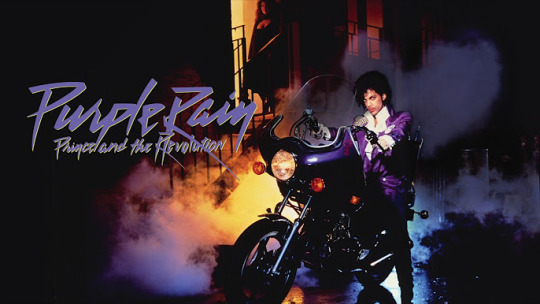
Purple Rain at 40: Speaking with The Revolution on the film which made Prince a pop superstar and changed my life
I sat in a darkened movie theater 40 years ago, transfixed by a story that felt like it was centered on my pop culture life. Only years later, would I wind up living a reality that felt imported straight from the film’s narrative.
The movie was Prince’s introduction to superstardom, Purple Rain.
That film is now celebrating its 40th anniversary – the actual date was Saturday – and to mark the occasion for NPR, I caught up with two of Prince’s bandmates from The Revolution, guitarist Wendy Melvoin and drummer Bobby Z Rivkin -- with Morris Day, lead singer/leader of the Purple One’s funk band offshoot The Time chiming in through email. (read the story here)
Back then, I was a straight up disciple of Prince’s Minneapolis sound – a fan after listening to his 1981 album Controversy, I sifted through albums like 1999, Dirty Mind and For You for the funk bits that made an aspiring drummer sit up and take notice. To be honest, like a lot of Black folks back then, I was little more into the hardankle funk of The Time, with me and my friends growing up in Gary Indiana regularly sporting the Stacy Adams shoes and baggy pants favored by the group.

So imagine my surprise when I saw all that pop culture uniqueness splashed all over a movie screen in July 1984 courtesy of Purple Rain. Prince charged through scenes on a custom-made, lavender colored motorcycle like a guitar playing superhero, thundering through dazzling musical sequences like a new school James Brown, while Day and his onstage foil Jerome Benton provided the kind of comic relief needed to keep the whole scene from taking itself too seriously.
As someone who had just started a funk band in college at Indiana University, I was in awe of the powerful pop tunes and kinetic, sharp performances in the film’s musical moments. And backstage scenes where Wendy fought with Prince – known only as The Kid onscreen – urging him to play a song she and her girlfriend/keyboardist Lisa Coleman had written together, felt like 100 arguments I’d seen in all the band I’d ever played in.
“It was sort of the perfect mix of time, place and people,” Wendy told me a few weeks ago, when I interviewed her by Zoom about the experience of making Purple Rain. “They wanted the dynamic to be as real as possible. So they did, when they were writing the script, come to us and say, okay, what would you say if this situation happened? Or how would you act if that happened? So they were able to capture a kind of authenticity and put in into the script.”
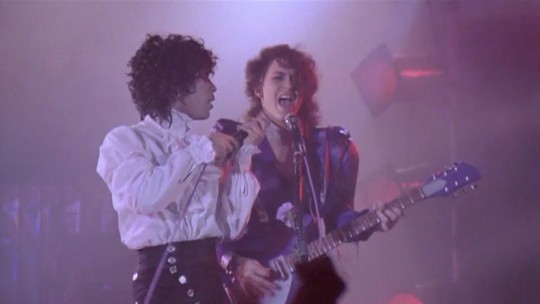
The film turned Prince into a superstar, powered by a simple story: The Revolution is on the verge of failure until The Kid agrees to play Wendy and Lisa’s song – Purple Rain, of course—at the legendary Minneapolis club First Avenue. His emotional performance kicks off a scorching finale that galvanizes the crowd and saves the band.
Just a few years later, I would live that same storyline when the group I co-founded in college, Voyage Band, was on the verge of failure, rescued by a hit single written for a charity record that exploded over local radio in 1986. When we played a show at a local club that we expected to be lightly attended, and the place instead packed with fans who sang along with our song when we played it onstage, I felt like I was living the story of Purple Rain in real time. Eventually, we signed contract with Motown Records, though our record was never released - the song Strange Situation, can be heard here.
Back in the mid-1980s, MTV had only recently begun playing videos by Black artists. And there was nothing like the level of information available to fans now about their favorite performers via social media. So seeing music videos and a film that provided a fictionalized history for Prince – showing him struggling with an abusive father and navigating tensions with his band – felt like a brief window into an artistic world fans had previously only seen through listening to the music and poring over album liner notes.
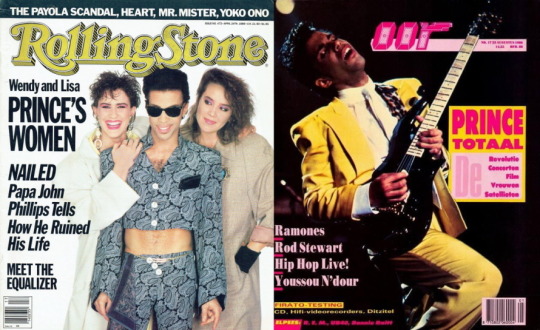
All of it was shrouded by a mystique in which Prince and his collaborators rarely talked with the press, which helped stoke interest in the work, but also made it tough for some musicians from The Revolution when Prince decided to disband the group in 1986.
“I kind of resented the fact that, you know, people just thought I turned on a machine and went to play and then turned it off,” said Bobby, who began working with Prince in the late 1970s and stayed friends with him until the pop icon’s death in 2016 of an accidental fentanyl overdose. “There was a lack of transparency about how it all went down…But I knew the mystique was cool…definitely didn’t want to blow that. And he trusted us to not give out the secret sauce.”
I actually met Prince months before his death at his home studio in Minneapolis, Paisley Park. He had invited the National Association of Black Journalists, which had a conference in the city, to his facility, sitting down with a small crowd of us to talk passionately about the need for artists to retain control of their work in the face of the streaming revolution (here’s the story I wrote for NPR about it).
Wendy says The Revolution had talked with Prince about year before his death about reuniting; her last conversation with him was about plans to visit him at his home studio Paisley Park with her young son. Bobby recalls hearing local news reports in Minneapolis about an ambulance called to Paisley Park and then later learning of Prince’s death.
“This shy kid that I met…turned into one of the greatest entertainers of all time,” Bobby says. “I got to know him. He was probably my best friend….someone that people just revere and are mystified by and I got to have an intimate relationship musically and personally [with him.] He changed the world. And it’s just incredible to have lived that moment with him.”
All of this explains why Purple Rain was such a landmark for me personally and pop music in general. It’s an achievement worth remembering, at a time when the march of technology and pop culture too often threatens to erase the memory of how we all got here, in the first place.
12 notes
·
View notes
Text

A word to the wise on Central Avenue in Indianapolis, Indiana.
87 notes
·
View notes
Video
Indiana Harbor Belt - Riverdale, IL by d.w.davidson Via Flickr: An eastbound IHB freight behind a pair of SW1500s, Nos. 9210 and 9201 is seen approaching Indiana Avenue, in June 1986.
40 notes
·
View notes
Text
makes you look at them




does anyone wanna see the stickers i put on my fuck off big water bottle
#sunset avenue ceramics is an incredible small business in bloomington indiana btw. i have three mugs from her so far and i need a million#also i edited the quote sticker to say louis may alcott instead of louisa. bc a) he went by that or lou#and b) all evidence including direct quotes from the man himself says he was trans#the word of chuck
5 notes
·
View notes
Text
5 notes
·
View notes
Text

Photo: Don Hogan Charles / The New York Times
* * * *
The O in the “LOVE” sculpture being lowered into place. It was cold and the skies leadenly forshadowed rain, but “LOVE” arrived monumentally in New York yesterday in time to gladden the city’s face for Christmas. “LOVE,” a five-ton sculpture by Robert Indiana, the pop artist, will be on display for the next six weeks at Fifth Avenue and 60th Street, at the entrance to Central Park, where it will be highly visible to midtown strollers and shoppers. [11-29-1971]
[follies of god]
+
“The longer I live, the more deeply I learn that love — whether we call it friendship or family or romance — is the work of mirroring and magnifying each other’s light. Gentle work. Steadfast work. Life-saving work in those moments when life and shame and sorrow occlude our own light from our view, but there is still a clear-eyed loving person to beam it back. In our best moments, we are that person for another.”
James Baldwin
15 notes
·
View notes